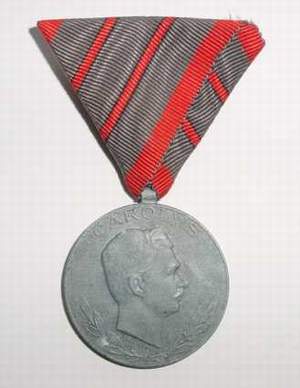 The war 1914-1918 brought about a completely new dimension in warfare, never before had the k.u.k. army been so
continuously in action with so many personnel engaged. This necessitated the consideration of decorations that had previously not been thought about. A large number of soldiers had given their "blood & health for the fatherland" without the possibility to earn an award for merit or bravery and it was an often expressed desire of the troops under arms to have a special sign to recognize this fact. When Kaiser Karl
acceded to the throne - he always had an open ear and heart for his soldiers in the field - he brought about this wish into reality by his order, dated 12th August 1917, in which he announced that orders had been given to work out the look and the details for the awarding of such a decoration. It took nearly a year before the "Statuten" (13th July 1918) and the details for awarding (25th July 1918) were published.
The war 1914-1918 brought about a completely new dimension in warfare, never before had the k.u.k. army been so
continuously in action with so many personnel engaged. This necessitated the consideration of decorations that had previously not been thought about. A large number of soldiers had given their "blood & health for the fatherland" without the possibility to earn an award for merit or bravery and it was an often expressed desire of the troops under arms to have a special sign to recognize this fact. When Kaiser Karl
acceded to the throne - he always had an open ear and heart for his soldiers in the field - he brought about this wish into reality by his order, dated 12th August 1917, in which he announced that orders had been given to work out the look and the details for the awarding of such a decoration. It took nearly a year before the "Statuten" (13th July 1918) and the details for awarding (25th July 1918) were published.
The medal was to be made of "Kriegsmetall" a zinc-alloy popular during the war and the ribbon, field-green with red edges, would show in the middle small red stripes for each wound received e.g. 1 strip for one wound up to 5 strips for 5 or more wounds (wounds which were received during the same day/action would count as one) and no stripes for severely damaged health caused by the circumstances of doing duty with the army in the field. The drawings of both sides of the medal and the ribbons were published together with the Statuten and are shown below.
All persons who were engaged with the army in the field could receive this award, these were not only soldiers but also members of the foreign legions and members of the civil auxiliary units like the Red Cross etc. The right and the bureaucratic details to award this medal were delegated to the Armee- and Korps commanders and to the territorial commands in the cases of retired personnel. The winners received a small "legitimation" paper together with the medal. If a higher number of strips were reached only the new ribbon would be awarded to the entitled recipient. Personnel with self-inflicted wounds or those who had lost the right to wear medals in the case of criminal delinquency or who died of their wounds or in other circumstances were exempted from receiving this decoration. Obviously it would take a long time to find out in the case of every serviceman just how many wounds he had received during the war years and so it was announced, to avoid any injustice, that the date of the first day when the new medal could be worn for the first time would be published separately. On the 6th August 1918 it was then published that the first day of wearing would be the 17th of August 1918, additional to this it was announced that the medals and ribbons would be issued to the troops as soon as the slow production permitted it!
In face of this last announcement it seems clear that only a very small number of medals would have been awarded regularly before the war's end, but the medals and ribbons were produced and surely the majority of the awardees received their medals after the war directly from the producers. The wound medal was in many respects similar to the Karl-Truppen-Kreuz; it was one of the very few cases where men, NCOs and officers were treated equally, for instance the higher officers who received this decoration were Generaloberst Schönburg-Hartenstein (2 strips) and Admiral Horthy!